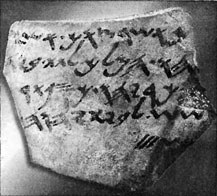|

Some Scholars Remain Skeptical About Yahweh Inscription
From the BASNY Explorer
 The
lack of a traceable provenance for the “House of Yahweh”
inscription leaves many questions in the minds of scholars. The item
needs to be subjected to a variety of scientific tests, many of which
have already been performed, to authenticate its legitimacy. The
lack of a traceable provenance for the “House of Yahweh”
inscription leaves many questions in the minds of scholars. The item
needs to be subjected to a variety of scientific tests, many of which
have already been performed, to authenticate its legitimacy.
Among the chief critics objecting to a rush to judgement are a group
of scholars often referred to as either the Copenhagen Group or
“minimalists.” They believe that biblical Israel originated
in either the Persian or Hellenistic era, and that evidence for an
earlier existence is unreliable. While some of the chief proponents
of this view teach at the University of Copenhagen, including Thomas
Thompson and Niels Lemche, thus the name Copenhagen Group, the circle
includes a larger number of mostly European scholars including Philip
Davies at the University of Sheffield in England.
While acknowledging a number of archaeological finds that seem to
have biblical parallels, they note that there is little evidence that
these finds refer specifically to “biblical” Israel. The
Merneptah stele from the 13th century bc, for instance, mentions the
name Israel but lacks sufficient data to indicate that this Israel
was the biblical Israel as opposed to a group of people known as
Israel that may have given their name to a territory that was later
occupied by the people who became biblical Israel and who took their
name from the pre-existing territorial name.
Recent finds, however, have generated a lot of conflict between the
minimalists and the mainstream. Not only do we have this new
“House of Yahweh” inscription, apparently dating to between
the ninth and seventh centuries BC, we also have the recent
“House of David” inscription (see illustration above)
dating to about the same time frame.
Among the arguments raised by the Copenhagen group is that the format
in which the controversial letters are arranged has led to an
erroneous translation of the names. Other inscriptions, such as one
found at Tel Dan, as well as the Mesha stone, generate additional
challenges. Some minimalists even suspect that some of these
inscriptions may be either a hoax or dated to the wrong time period.
|